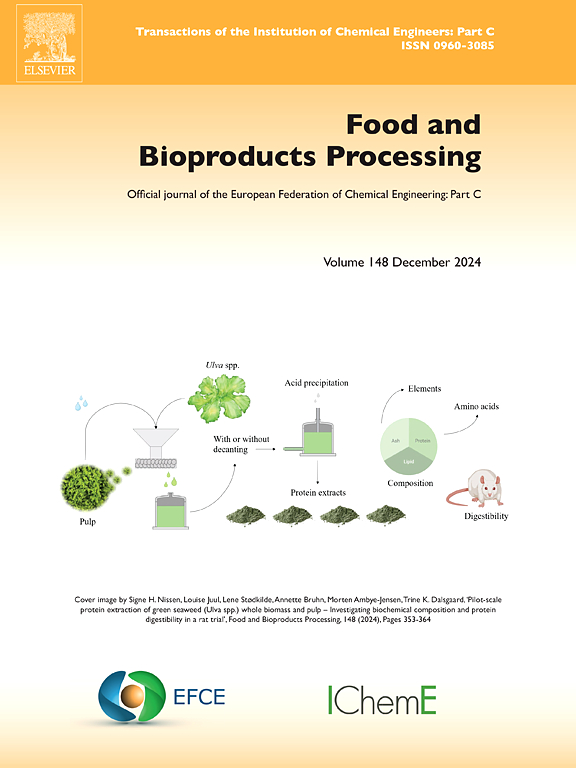Purification of sinapic acid from mustard bran enzymatic hydrolysate by adsorption on macroporous resins
IF 3.5
2区 农林科学
Q2 BIOTECHNOLOGY & APPLIED MICROBIOLOGY
引用次数: 0
Abstract
This work focuses on the adsorption chromatography process to purify sinapic acid from mustard bran hydrolysate, an agro-industrial by-product generated in large quantities during mustard seed processing. The adsorption and desorption capacities of sinapic acid on four macroporous adsorbent resins were determined in batch mode, for both a real hydrolysate and model solutions. The results showed that the best adsorption capacity was obtained with XAD16 and FPX66 resins and adsorption isotherm data were well represented by a Langmuir model. The desorption ratios by ethanol were high, with a maximum value of 98 ± 1 % at 90 % (v/v) ethanol fraction for XAD16 resin. XAD16 resin was selected for the dynamic purification, and optimized results showed an adsorption capacity of 75.6 mg/g for sinapic acid, corresponding to a breakthrough volume of around 50-fold of the resin bed volume (BV) at the feed flow rate of 2 BV/h. Complete desorption was achieved with 8 BV of 90 % (v/v) ethanol at the elution flow rate of 2 BV/h, resulting in a recovery yield of around 97 %. The purification process achieved an 8.6-fold concentration of sinapic acid, with a 37-fold increase in purity (from 0.50 % to 18.4 %) and a 7.4-fold enhancement in potential antioxidant activity, reaching 341 ± 24 mg of Trolox equivalents/100 mL. This process has been proven to be highly efficient and could contribute to the design of industrial-scale purification of sinapic acid from mustard bran hydrolysate.
大孔树脂吸附纯化芥菜皮酶解液中辛酸的研究
本文研究了从芥菜籽加工过程中大量产生的农工业副产物——芥菜糠水解物中纯化芥菜酸的吸附色谱法。在批量模式下,测定了四种大孔吸附树脂对辛酸的吸附和解吸能力,包括实际水解产物和模型溶液。结果表明,XAD16和FPX66树脂的吸附量最佳,吸附等温线数据符合Langmuir模型。乙醇解吸率高,在90 % (v/v)乙醇分数下,XAD16树脂的解吸率最大值为98 ± 1 %。选择XAD16树脂进行动态净化,优化结果表明,在进料流量为2 BV/h时,sinapic酸的吸附量为75.6 mg/g,对应的突破体积约为树脂床体积(BV)的50倍。在90 % (v/v)乙醇浓度为8 BV、洗脱流速为2 BV/h的条件下,完全解吸,回收率约为97 %。纯化过程获得了8.6倍浓度的辛酸,纯度提高了37倍(从0.50 %提高到18.4 %),潜在抗氧化活性提高了7.4倍,达到341 ± 24 mg Trolox当量/100 mL。该工艺已被证明是高效的,可以为从芥菜糠水解物中提纯芥子酸的工业规模设计做出贡献。
本文章由计算机程序翻译,如有差异,请以英文原文为准。
求助全文
约1分钟内获得全文
求助全文
来源期刊

Food and Bioproducts Processing
工程技术-工程:化工
CiteScore
9.70
自引率
4.30%
发文量
115
审稿时长
24 days
期刊介绍:
Official Journal of the European Federation of Chemical Engineering:
Part C
FBP aims to be the principal international journal for publication of high quality, original papers in the branches of engineering and science dedicated to the safe processing of biological products. It is the only journal to exploit the synergy between biotechnology, bioprocessing and food engineering.
Papers showing how research results can be used in engineering design, and accounts of experimental or theoretical research work bringing new perspectives to established principles, highlighting unsolved problems or indicating directions for future research, are particularly welcome. Contributions that deal with new developments in equipment or processes and that can be given quantitative expression are encouraged. The journal is especially interested in papers that extend the boundaries of food and bioproducts processing.
The journal has a strong emphasis on the interface between engineering and food or bioproducts. Papers that are not likely to be published are those:
• Primarily concerned with food formulation
• That use experimental design techniques to obtain response surfaces but gain little insight from them
• That are empirical and ignore established mechanistic models, e.g., empirical drying curves
• That are primarily concerned about sensory evaluation and colour
• Concern the extraction, encapsulation and/or antioxidant activity of a specific biological material without providing insight that could be applied to a similar but different material,
• Containing only chemical analyses of biological materials.
 求助内容:
求助内容: 应助结果提醒方式:
应助结果提醒方式:


